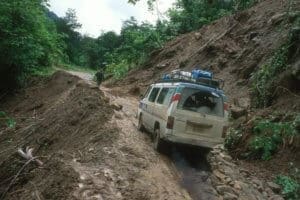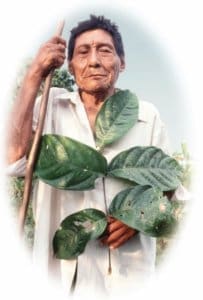Courses through acres of cedars and oaks, sedges and ferns. With an average of 17 tree species per acre, the mountains of southern Oregon are often touted as the richest flora in the western USA. In the Amazon Rainforest – a journey of 5 thousand miles from my home – where I am often cast into research, a thriving botanical Eden sprouts from nearly infertile and cloying wet soils, almost all of it unsuitable for human endeavors of agriculture and ranching. There, from a single hectare of soil, nearly 300 species of trees and 4,000 other angiosperms thrive in a complex ecology. In a vertical rise to the cloud forest and puna, the 16,ooo foot ridges of the Andes peak over our Amazon farm, a course of just fifty miles. In this short journey, the world’s greatest taxonomists have counted more than 30,000 botanical species, each manufacturing a unique chemical matrix and offering a genuine affiliation for it’s specific niche: a true altruism for the humans lucky enough to abound there.
 Throughout Amazonia, be it the puna or the lowland plains, the crenelation of green is, in actuality, a laboratory filled to its brim. As the equatorial elements (heat, and a continuous humidity that soars above 95 percent)meld, the forces of nature conjoin by some great fate with the emergence of Amerindian culture and what is considered the wealthiest body of botanical treasure on Earth. Be it a miracle in progress or chaos that took form and sprouted into good fortune by happenstance, to Amazonia and to the children who credit their origins there, we owe much homage. To many who dwell there, Amazonia is a healing forest, a staggering medical pharmacopeia that exists today in almost unimaginable proportions. From what might have originally seemed only a riot of foreboding wilderness, the combination of chemistry, pharmacology and parapsychology gave rise to a venerable linage of highly trained medical practitioners, all of them accomplished doctors, nurses, psychologists and spiritual counselors. Many of them are directly descended from medical experts who spent two thousand years crafting and defining a medicinal pharmacology that predates written history. Today this pharmakon is resplendent and replete with systems of internal medicine. Here an entire ‘whole-patient’ healing tradition is as precise and as practiced as any in the West. This pharmacy continues to beckon and allure philosophers and chemists of our new medical era. In Amazonia past and present, Curanderos, Piejes, Shamans or ‘Savages’, no matter how they were known, were actually masters of psychology, nutrition and botanical medicines.
Throughout Amazonia, be it the puna or the lowland plains, the crenelation of green is, in actuality, a laboratory filled to its brim. As the equatorial elements (heat, and a continuous humidity that soars above 95 percent)meld, the forces of nature conjoin by some great fate with the emergence of Amerindian culture and what is considered the wealthiest body of botanical treasure on Earth. Be it a miracle in progress or chaos that took form and sprouted into good fortune by happenstance, to Amazonia and to the children who credit their origins there, we owe much homage. To many who dwell there, Amazonia is a healing forest, a staggering medical pharmacopeia that exists today in almost unimaginable proportions. From what might have originally seemed only a riot of foreboding wilderness, the combination of chemistry, pharmacology and parapsychology gave rise to a venerable linage of highly trained medical practitioners, all of them accomplished doctors, nurses, psychologists and spiritual counselors. Many of them are directly descended from medical experts who spent two thousand years crafting and defining a medicinal pharmacology that predates written history. Today this pharmakon is resplendent and replete with systems of internal medicine. Here an entire ‘whole-patient’ healing tradition is as precise and as practiced as any in the West. This pharmacy continues to beckon and allure philosophers and chemists of our new medical era. In Amazonia past and present, Curanderos, Piejes, Shamans or ‘Savages’, no matter how they were known, were actually masters of psychology, nutrition and botanical medicines.

They devised multi-step systems for extracting thousands of beneficial drugs and compound formulations directly from the Amazon Rainforest, with delivery systems so novel that even today these drugs produce actions that rival modern medications. These are the essential material prima for stunning new phytochemical contributions. Dozens of these plant-based drugs are now fractioned by chemists and are deemed so intricate and chemically profound – so exacting in their function – that as one scientist put it, “impossible for any scientist to copy in a laboratory, let alone ‘imagine!’” Understanding and unraveling the phytochemical components and the fine art of enticing ensemble extracts, tonic emollients, teas, lotions and internal pro-biotics from plants ripe with vital life energies is no small task rushed by a single lifetime.
 From midwife to master healer, Amazon Amerindians parlayed in a language which was attuned to the sensitivity of nuances. They consciously accelerated the advancement of their medical system by astute training, which in many cases lasted decades before graduation. Many of their compounds are still so little understood in their actions that they seem to dance only as a vision on an ethereal plain, leaving science baffled as to their methods of action. Still others, with no apparent function at all but to serve as an adjunct to healing, awaken the intuition and point both ‘healer and patient’ to the very origin of disease itself. Genius indeed.
From midwife to master healer, Amazon Amerindians parlayed in a language which was attuned to the sensitivity of nuances. They consciously accelerated the advancement of their medical system by astute training, which in many cases lasted decades before graduation. Many of their compounds are still so little understood in their actions that they seem to dance only as a vision on an ethereal plain, leaving science baffled as to their methods of action. Still others, with no apparent function at all but to serve as an adjunct to healing, awaken the intuition and point both ‘healer and patient’ to the very origin of disease itself. Genius indeed.
